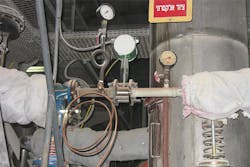Vortex flowmeters prove their worth in steam flow measurement
Vortex flowmeters offer accurate and reliable flow measurement at a competitive price. Even though vortex meters are not as accurate as Coriolis meters, they offer accuracy readings of better than 1 percent, depending on fluid and application. And while vortex meters are somewhat intrusive compared to magnetic and ultrasonic meters, they are much less intrusive than the orifice plates used with DP transmitters to measure flow. Pressure drop from vortex meters is minimal, since most shedder bars are relatively small in size.
Not only can vortex flowmeters offer an accurate and reliable flow measurement, they can also handle a wider range of process conditions than almost any other flowmeter. Vortex meters can handle liquids, gases and steams. Coriolis meters, on the other hand, are well known for their ability to handle liquids, but they are less widely used on gases, and their use for steam measurement is just emerging. Ultrasonic meters have been used to measure gas flow since the 1980s, but they are only beginning to be used for steam. By contrast, the use of vortex meters to measure steam flow is well established, and they have proven capable of handling the high pressures and temperatures associated with steam flow.
Steam is the most difficult fluid to measure, due to its high pressure and high temperature and because the measurement parameters vary with the type of steam. The three main types of steam are wet steam, saturated steam, and superheated steam.
READ ALSO:
- Energy and Large-Pipe Applications Drive Coriolis Technology to New Heights
- Differential Pressure Maintains a Powerful Place in the World of Flow Measurement
- Magmeters Top the Flowmeter Market In Revenue
- PD Flowmeters Poised to Gain from Oil & Gas Application Opportunities
- Emissions Monitoring Applications Propel Thermal Flowmeter Market
- Turbine Flowmeters Remain Competitive in Turbulent Market
- Custody-Transfer Applications Drive Ultrasonic Flowmeter Growth
Steam is often measured in process plants and for power generation. Vortex and DP flowmeters are the primary meters used to measure steam. Magnetic flowmeters cannot measure steam flow, and Coriolis and ultrasonic flowmeters are, as noted earlier, just beginning to be used for this purpose. In addition to their ability to tolerate high process temperatures and pressures, vortex meters have wide rangeability, which allows them to measure steam flow at varying velocities. This is particularly helpful in process and power plants where steam is often measured coming from a boiler.
One recent development in vortex flowmeters is dual-sensor meters. When a bluff body generates vortices, a downstream sensor detects the vortices and counts how many there are. These sensors are typically ultrasonic, piezoresistive or capacitive. One recent innovation is to have two sensors downstream to detect the vortices. This provides redundancy, making the flowmeter more reliable, though it doesn’t necessarily enhance performance.
Another innovation is to have two vortex flowmeters in the same line and calibrate them together. This also provides redundancy and is somewhat like having two ultrasonic flowmeters running in the same line for custody-transfer applications. While this arrangement does not improve the performance of the individual meters, it does make for a more stable and reliable installation.
In January 2007, an API committee approved a draft standard for the use of vortex flowmeters for custody transfer of liquid and gas. This standard was updated in 2010. While the final form of this draft standard is still not determined, its approval is likely to boost sales of vortex meters over time, as suppliers develop products that conform to the standard.
To read more about Flow Research’s work in the area of vortex flow measurement, visit flowvortex.com.
Jesse Yoder
Jesse Yoder, Ph.D., is president of Flow Research Inc. He has 30 years of experience as an analyst and writer in instrumentation. Yoder holds two U.S. patents on a dual-tube meter design and is the author of "The Tao of Measurement," published by ISA. He may be reached at [email protected]. Find more information on the latest study from Flow Research, "The World Market for Gas Flow Measurement, 4th Edition," at www.gasflows.com.


